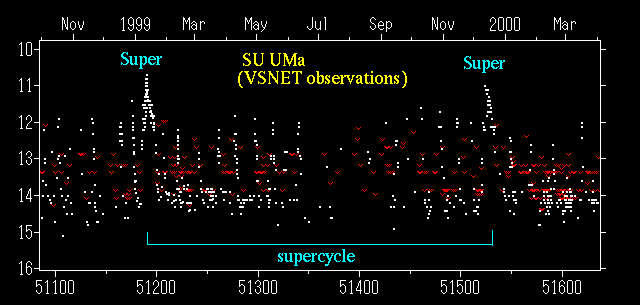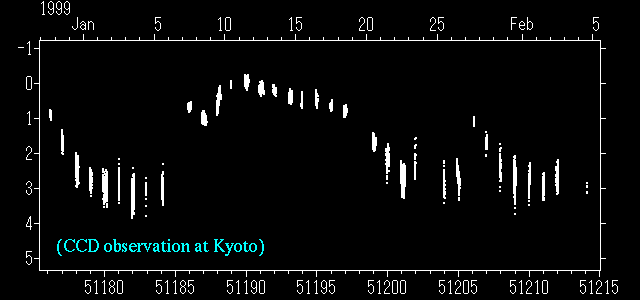
(Light curve of SU UMa from VSNET observations)

(Enlarged light curve of SU UMa)
In spite of the apparent success of thermal instability theory to explain the many observational features of many classes of CVs, a subgroup called SU UMa stars had remained defying reasonable explanation. The SU UMa stars are originally characterized by presence of long-lasting, bright outbursts called "superoubursts" in addition to normal outbursts which are observationally equivalent to outbursts of SS Cyg-type stars. Instrumental development, such as high-speed photometry and time-resolved spectroscopy, led to a plenty of observational knowledge about SU UMa stars and superoutbursts in the late 1970's and early 1980's.


(Enlarged light curve of SU UMa)

The main characterstics of superoutbursts can be summarized as follows:
1) The duration of a superoutburst is at least several times longer than those of normal outbursts. The typical duration is an order of ten days.
2) The maximal brightness of a superoutburst is about one magnitude brighter than those of normal outbursts.
3) Superoutburst light curve shows gradual exponential decline (about 0.1-0.2 mag/day), followed by a rapid terminal decline.
4) Superoutbursts occur more regularly than normal outbursts. The typical interval between two successive superoutbursts (later we call it "supercycle") is 100 to 1000 days, depending on the object.


In addition to these features, the superoutbursts show unique light variation called "superhumps". Superhumps resembles in shape orbital humps in quiescence (which are believed to arise from the hot spot where the accretion stream from the secondary collides with the accretion disk), but have a much larger (about 100 times) luminosity, which amounts to an amplitude of a few tenths of magnitude during superoutbursts. This is why these humps are called "super" ones. Most striking feature of the superhumps is found in its period: the period of light variation is a few percent longer than the orbital period of the binary determined by the radial velocity study. At present, the existence of superhumps is considered to be the definition of a superourtburst, rather than its general outburst characteristics.
 sample of superhump light curves
sample of superhump light curves
Yet another striking feature of SU UMa stars is their orbital period distribution. Almost all SU UMa stars occupy below the "period gap", between 2.2 and 2.8 hrs in which the number density of CVs is markedly decreased. The only exception is TU Men. Very recently, a few stars (NY Ser, GX Cas, MN Dra = Var73 Dra) are shown by the VSNET team to have periods in the period gap.
Several mechanisms to account for the superhumps have been historically proposed ranging from the spot on an asynchronously rotating secondary star from the eccentricity of the binary orbit. None of the mechanisms could reasonably explain all the observational features of superhumps, superoutbursts and orbital period distribution characteristic to SU UMa stars. One must wait a decade for another intrinsic disk instability called "tidal instability" or "tidally driven eccentric instability" which was first discovered by 2-D numerical simulation of an accretion disk by Whitehurst (1988). The basic results of Whitehurst was confirmed by hydrodynamical simulations by Hirose and Osaki (1990) and by Lubow (1991).
The tidal instability theory predicts that the accretion disk is deformed when the disk reaches a critical radius in a binary with a high (q = M1/M2 > 4) mass-ratio due to the 3:1 dynamical resonance between the orbital motions of the secondary star and the particle in the disk (Whitehurst 1988; Hirose and Osaki 1990). A precession of the deformed disk in a non-axisymmetric gravity field, and a varying tidal dissipation resulting from a periodic modulation of viscous heating for varying aspect of the secondary against the disk naturally explains the superhump light variation and the difference in the superhump period (Psh) from the orbital period (Porb). The mass-ratio criterion of this tidal instability is shown to basically define the orbital period distribution of SU UMa-type stars among dwarf novae, that is, the high (q = M1/M2 > 4) mass-ratio is achievable only in short orbital systems in CVs due to the Porb vs. mass relation of Roche-lobe filling main-sequence secondaries and limited mass range of white dwarf primaries (Whitehurst 1988), altough the lower limit of the mass ratio in SU UMa stars still awaits observational confirmation.
The remaining feature of SU UMa stars - existence of normal- and superoutbursts and characteristic recurrence pattern - was explained by combination of the thermal and tidal instabilities (Osaki 1989). In SU UMa stars, the disk radius gradually increases by experiencing normal outbursts, then the tidal instability is triggered when the disk exceeds the critical radius during the "final" normal outburst The resulting eccentric deformation of the disk and effective angular momentum removal via tidal dissipation cause a superoutburst. The superoutburst is thus triggered by a normal outburst. During a superoutburst, a large part of mass in the disk is accreted and the disk effectively shrinks to start a new cycle of normal outbursts. This cyclic variation of disk radius accompanied by one superoutburst and intervening normal outbursts is called "supercycle".
 Return to Daisaku Nogami's page
Return to Daisaku Nogami's page
